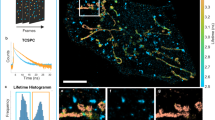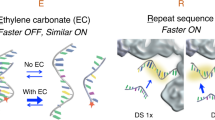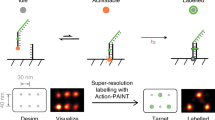Abstract
Although current implementations of super-resolution microscopy are technically approaching true molecular-scale resolution, this has not translated to imaging of biological specimens, because of the large size of conventional affinity reagents. Here we introduce slow off-rate modified aptamers (SOMAmers) as small and specific labeling reagents for use with DNA points accumulation in nanoscale topography (DNA-PAINT). To demonstrate the achievable resolution, specificity, and multiplexing capability of SOMAmers, we labeled and imaged both transmembrane and intracellular targets in fixed and live cells.
This is a preview of subscription content, access via your institution
Access options
Access Nature and 54 other Nature Portfolio journals
Get Nature+, our best-value online-access subscription
$29.99 / 30 days
cancel any time
Subscribe to this journal
Receive 12 print issues and online access
$259.00 per year
only $21.58 per issue
Buy this article
- Purchase on Springer Link
- Instant access to full article PDF
Prices may be subject to local taxes which are calculated during checkout



Similar content being viewed by others
References
Hell, S. W. & Wichmann, J. Opt. Lett. 19, 780–782 (1994).
Betzig, E. et al. Science 313, 1642–1645 (2006).
Hess, S. T., Girirajan, T. P. & Mason, M. D. Biophys. J. 91, 4258–4272 (2006).
Rust, M. J., Bates, M. & Zhuang, X. Nat. Methods 3, 793–795 (2006).
Sahl, S. J., Hell, S. W. & Jakobs, S. Nat. Rev. Mol. Cell Biol. 18, 685–701 (2017).
Dai, M., Jungmann, R. & Yin, P. Nat. Nanotechnol. 11, 798–807 (2016).
Balzarotti, F. et al. Science 355, 606–612 (2017).
Schnitzbauer, J., Strauss, M. T., Schlichthaerle, T., Schueder, F. & Jungmann, R. Nat. Protoc. 12, 1198–1228 (2017).
Jungmann, R. et al. Nano Lett. 10, 4756–4761 (2010).
Ries, J., Kaplan, C., Platonova, E., Eghlidi, H. & Ewers, H. Nat. Methods 9, 582–584 (2012).
Opazo, F. et al. Nat. Methods 9, 938–939 (2012).
Gomes de Castro, M. A., Höbartner, C. & Opazo, F. PLoS One 12, e0173050 (2017).
Gold, L. et al. PLoS One 5, e15004 (2010).
Gupta, S. et al. Appl. Immunohistochem. Mol. Morphol. 19, 273–278 (2011).
Rohloff, J. C. et al. Mol. Ther. Nucleic Acids 3, e201 (2014).
Endesfelder, U. & Heilemann, M. Nat. Methods 11, 235–238 (2014).
Culley, S. et al. Nat. Methods 15, 263–266 (2018).
Jungmann, R. et al. Nat. Methods 13, 439–442 (2016).
Huang, B., Wang, W., Bates, M. & Zhuang, X. Science 319, 810–813 (2008).
Jungmann, R. et al. Nat. Methods 11, 313–318 (2014).
Otsuka, S. et al. eLife 5, e19071 (2016).
Gupta, S. et al. J. Biol. Chem. 289, 8706–8719 (2014).
Beaucage, S. L. & Caruthers, M. H. Tetrahedr. Lett. 22, 1859–1862 (1981).
Carlson, M., Carter, J. D. & Rohloff, J. Green Chemistry Letters and Reviews 8, 37–39 (2015).
Mullah, B., Livak, K., Andrus, A. & Kenney, P. Nucleic Acids Res. 26, 1026–1031 (1998).
Whelan, D. R. & Bell, T. D. Sci. Rep. 5, 7924 (2015).
Sbalzarini, I. F. & Koumoutsakos, P. J. Struct. Biol. 151, 182–195 (2005).
Schueder, F. et al. Nat. Commun. 8, 2090 (2017).
Acknowledgements
We thank M. Spitaler and the imaging facility of the MPI of Biochemistry for confocal imaging support, and A. Auer and F. Schueder for super-resolution microscopy support. This research was funded by the German Research Foundation through the Emmy Noether Program (DFG JU 2957/1-1 to R.J.), the European Research Council through an ERC Starting Grant (MolMap; grant agreement number 680241 to R.J.), the Allen Distinguished Investigator Program through The Paul G. Allen Frontiers Group (J.E. and R.J.), the Max Planck Society (R.J.), the Max Planck Foundation (R.J.), the QBM graduate school (S.S.), and the IMPRS-LS graduate school (M.T.S.). We thank our SomaLogic colleagues in discovery, process chemistry, and analytical chemistry for their support of this project. SOMAmer reagent is a registered trademark of SomaLogic, Inc.
Author information
Authors and Affiliations
Contributions
S.S. designed and performed experiments and analyzed the data. P.C.N. designed experiments. M.T.S. analyzed data and wrote software. V.J.S. and J.E. created the Nup107–GFP cell line. J.D.C., S.G., and N.J. contributed to generation of SOMAmer reagents and provided guidance on their use. R.J. conceived of and supervised the study and analyzed the data. S.S., P.C.N., and R.J. wrote the manuscript, and all authors reviewed and approved the manuscript.
Corresponding author
Ethics declarations
Competing interests
J.D.C., S.G., and N.J. are SomaLogic, Inc., employees and stakeholders.
Additional information
Publisher’s note: Springer Nature remains neutral with regard to jurisdictional claims in published maps and institutional affiliations.
Integrated supplementary information
Supplementary Figure 1 Three-target Exchange-PAINT with SOMAmers in SK-BR-3 cells.
(a) Simultaneous labeling followed by sequential imaging using SOMAmers against EGFR (cyan), ErbB2 (green), and HSP90 (red). Merged image, all targets were acquired using Cy3b-labeled imager strands. (b) EGFR channel only. (c) ErbB2 channel only. (d) HSP90 channel only. Scale bars: 500 nm.
Supplementary Figure 2 Two-target 3D Exchange-PAINT with SOMAmers in SK-BR-3 cells.
(a) Simultaneous labeling followed by sequential imaging using SOMAmers against HSP60 (cyan) and LIMP-2 (red). All targets were acquired using Cy3b-labeled imager strands. (b) 100-nm z-slices of highlighted area in a. Scale bars: 2 µm (a), 500 nm (b).
Supplementary Figure 3 Different EGFR staining intensities in A431 and A549 cells.
First, we stained the intracellular EGFR domain with primary and secondary antibodies. Next, the extracellular EGFR was stained with the Cy3 conjugated SOMAmer reagent. Confocal images were recorded at the basal membrane of the cells. Staining intensities of both antibody and SOMAmer correlated with the expression level of EGFR of A431 cells (high) and A549 cells (low), demonstrating the specific staining of EGFR. Scale bar: 20 µm.
Supplementary Figure 4 EGFR SOMAmer and antibody costaining.
Z-Projections of a 5 µm thick confocal Z-Stack (10 slices in total, 0.5 µm step size per slice) through several A549 cells. Left: SOMAmer staining of EGFR. Middle: Conventional antibody staining of EGFR. Right: SOMAmer and antibody signal merged. The high degree of co-localization shows the specificity of the SOMAmer to EGFR. Scale bar: 15 µm.
Supplementary Figure 5 EGFR SOMAmer staining before and after EGF stimulation.
Left: Untreated, serum-starved A549 cells showed a uniform EGFR staining in the plasma membrane. Right: After EGF stimulation of the A549 cells, distinct vesicles and highly reduced signal from the plasma membrane was observed. Scale bar: 20 µm.
Supplementary Figure 6 EGFR SOMAmer versus antibody linkage error comparison.
(a) DNA-PAINT overview image of SOMAmer-stained EGFR proteins. (b) DNA-PAINT overview image of primary- and DNA-conjugated-secondary-stained EGFR proteins. (c) ~ 20,000 single receptor molecules labeled using SOMAmers aligned by their center of mass (left). 1D histogram of localizations yields a combined labeling and imaging precision of 4.4 nm (right). (d) ~ 30,000 single receptor molecules labeled using antibodies aligned by their center of mass (left). 1D histogram of localizations yields a combined labeling and imaging precision of 9.4 nm. The difference between SOMAmer- and antibody-based labeling stems almost exclusively from the increased linkage error of the primary/secondary antibody sandwich, as we localize single molecules in both experiments with ~ 4 nm precision. This demonstrates that SOMAmer labels in this case are not the precision-limiting factor when imaging single EGFR protein molecules, while antibody labeling broadens the true protein localization roughly two-fold.
Supplementary Figure 7 EGFR SOMAmer versus antibody quantitative labeling comparison.
(a) qPAINT analysis of single EGFR proteins labeled with SOMAmer reagents (n = 2670) yields a unimodal distribution of binding events, confirming quantitative 1:1 labeling of EGFR proteins. (b) qPAINT analysis of single EGFR proteins (n = 3406) labeled with antibody reagents yields a multimodal distribution of binding events, confirming non-quantitative labeling of EGFR proteins.
Supplementary Figure 8 3D Exchange-PAINT imaging of PMP70 and catalase in A431 cells.
(a) Exchange PAINT image of PMP70 (cyan) labeled with primary and secondary antibodies and catalase (magenta) targeted using a SOMAmer reagent. (b, c) Zoom-ins into regions highlighted in (a). Exchange-PAINT imaging shows peroxisomal membrane protein PMP70 surrounding catalase which is located inside peroxisomes Scale bars: 2 µm (a), 500 nm (b-c).
Supplementary Figure 9 Comparison of different fixation conditions for SOMAmer staining in A431 cells.
Three different fixation conditions were tested for EGFR and catalase binding SOMAmer reagents. Fixation protocols significantly affect the staining intensity. Chemical fixation with only paraformaldehyde shows positive staining of both targets whereas addition of glutaraldehyde significantly decreased the signal. Methanol fixation resulted in high SOMAmer staining intensity for EGFR, but no signal could be observed for catalase. Scale bar: 15 µm.
Supplementary Figure 10 Mild fixation conditions favor SOMAmer binding to GFP.
Four different paraformaldehyde (PFA) concentrations and incubation times were evaluated for GFP SOMAmer staining intensity on HeLa Kyoto 2xZFN mEGFP–Nup107 cells. We saw increased SOMAmer-Cy3 signal (top row) for short incubation time and low PFA concentration. Unchanged signal from GFP (bottom row) shows preservation of the Nup107 protein for all tested fixation conditions. Scale bar: 15 µm.
Supplementary Figure 11 Addition of low-molecular-weight dextran sulfate blocks unspecific nuclear SOMAmer binding.
Fixed A549 cells were incubated with 100 nM of EGFR SOMAmer in SOMAmer staining buffer containing 100 µM Z-Block and either 1 µM (left) or 100 µM (right) dextran sulfate. The increase of dextran sulfate concentration led to a drastic decrease of signal in the nucleus. Scale bar: 20 µm.
Supplementary Figure 12 Addition of Z-Block quenches unspecific binding of SOMAmers to cellular organelles.
Fixed HeLa Kyoto 2xZFN mEGFP–Nup107 cells were incubated with 100 nM of EGFR SOMAmer in SOMAmer staining buffer containing 1 mM dextran sulfate and either 10 µM (top) or 100 µM (bottom) Z-Block. The increase of Z-Block concentration led to a drastic decrease of signal from cellular organelles. Scale bar: 10 µm.
Supplementary Figure 13 EGFR SOMAmer can be used to stain living cells with little unspecific binding.
(a) Staining of A431 cells with the GFP SOMAmer as a negative control led to only very little unspecific signal (left), which could be effectively quenched via the addition of 10 µM Z-Block (right). (b) SOMAmer staining of EGFR in living A431 cells (left) in comparison to conventional antibody staining (middle). The high degree of colocalization in the merged image (right) demonstrates the specificity of the SOMAmer staining on living cells. Scale bars: 20 µm (a), 10 µm (b).
Supplementary Figure 14 Live-cell DNA-PAINT single-particle trajectories.
(a) Exemplary frame from live-cell DNA-PAINT using EGFR-SOMAmer (Supplementary Movie 1) with spots detected for particle tracking. (b) Exemplary single-particle-trajectory of a DNA-PAINT imager targeting a diffusing SOMAmer-labeled EGFR protein (trajectory length ~ 2 s). Scale bars: 5 µm (a), 1 µm (b).
Supplementary information
Supplementary Text and Figures
Supplementary Figures 1–14, Supplementary Tables 1 and 2, Supplementary Notes 1 and 2, and Supplementary Methods
Supplementary Video 1
Live-cell DNA-PAINT single-particle tracking of EGFR. EGF receptors in living A431 cells were labeled with a SOMAmer carrying a DNA-PAINT docking site. Subsequent addition of transiently binding imager strands allowed tracking of single EGF receptors.
Rights and permissions
About this article
Cite this article
Strauss, S., Nickels, P.C., Strauss, M.T. et al. Modified aptamers enable quantitative sub-10-nm cellular DNA-PAINT imaging. Nat Methods 15, 685–688 (2018). https://doi.org/10.1038/s41592-018-0105-0
Received:
Accepted:
Published:
Issue Date:
DOI: https://doi.org/10.1038/s41592-018-0105-0
This article is cited by
-
Electrochemically controlled blinking of fluorophores for quantitative STORM imaging
Nature Photonics (2024)
-
Aptamer-based Membrane Protein Analysis and Molecular Diagnostics
Chemical Research in Chinese Universities (2024)
-
In vitro selection of aptamers and their applications
Nature Reviews Methods Primers (2023)
-
Regulation of ribosomal RNA gene copy number, transcription and nucleolus organization in eukaryotes
Nature Reviews Molecular Cell Biology (2023)
-
High-speed super-resolution imaging of rotationally symmetric structures using SPEED microscopy and 2D-to-3D transformation
Nature Protocols (2021)



